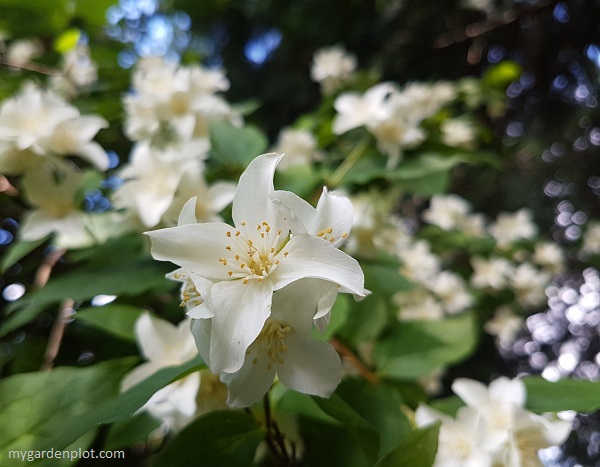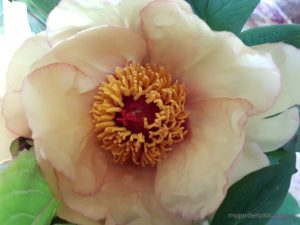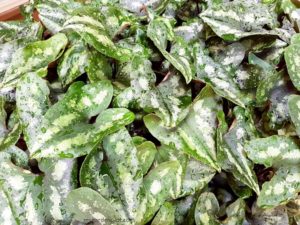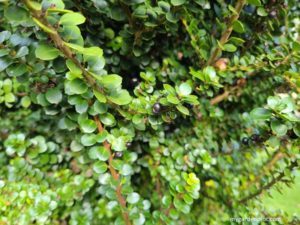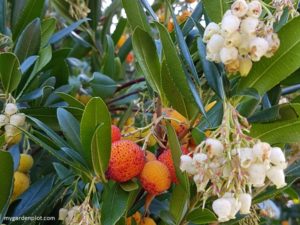Philadelphus (Mock Orange, Sweet Mock-Orange) Growing Tips
The Philadelphus or mock orange shrub is well-known for its pleasant smell. It is a hardy perennial with fragrant white or creamy colour flowers that bloom late spring and early summer. The mock orange is undoubtedly an attractive large shrub, too, with its long arching branches reaching over with dozens of small flower clusters. It attracts bees, butterflies and hummingbirds. Planted near a window or pathway, it captivates and draws you into the garden with its orange-scented blossoms. There are also a few hybrids that are smaller and more compact for a small garden bed. The mock orange is an easy-care deciduous shrub that needs pruning once a year – more below how to plant and grow a mock orange and the best time to prune it.
The mock orange is native to North and Central America, Asia and Europe. Here in British Columbia, the P. lewisii or ‘Wild Mock Orange’ is a native plant to the Pacific Northwest. It was introduced to Britain in 1825 by Scottish botanist David Douglas. It grows naturally in southern British Columbia through to northern California USA, and eastwards to Alberta in Canada and Montana in the USA. It is a beautiful multi-stemmed, medium to large type with snow-white fragrant flowers. As a side note, alternative spellings for this plant include mock-orange, or mockorange, or mock orange – in case you were wondering, all are acceptable.
Which Is The Most Fragrant Philadelphus (Mock Orange) Shrub
The enchanting citrus-like, fresh fragrance from the mock orange is often the initial attraction to adding this plant to a garden. And a frequently asked question is which mock orange has the strongest smell. While most species and varieties have a strong scent, there are a few more potent than others.
At the top of the list is the P. coronarius or ‘Sweet Mock Orange,’ which has a rich, intense fragrance. It is said to be the most fragrant of all the species. It is a large shrub and grows up to 3.5 metres and just as wide at full maturity, so it may not be suitable for all gardens. The smaller P. microphyllus or ‘Littleleaf Mock Orange’ is also heavily scented and grows to only about .75 metres. There are also a few cultivated hybrids with strongly scented blossoms, such as the P. ‘Avalanche’ and P. ‘Belle Etoile’. Keep these names in mind and check at your local garden store to see what varieties of mock orange are available in your area.
Philadelphus (Mock Orange) At A Glance
Type: Deciduous Shrub
Location: Full Sun / Partial Shade
Blooming Season: Late Spring / Early Summer
When To Prune: Mid / Late Summer (after flowering – see pruning tips below)
Height: Varies from .5 – 3.5 metres (1.5 – 12 feet)
Plant Hardiness Zones: 3, 4, 5, 6, 7, 8, 9
Where To Plant And How To Care For Mock Orange
The mock orange shrub thrives in a sunny location and can tolerate partial shade or light shade site. The soil should be moist, humus-rich and well-drained. It is best planted in autumn through to early spring-time.
Mock orange benefits with mulch in spring and an application of balanced organic slow-release fertilizer – this is especially needed when hard pruning.
Propagation is easy and can be done by seed, stem cuttings or root suckers. Start mid-summer for softwood cuttings (hardwood cuttings best taken in autumn) and keep in a greenhouse or in a cool area indoors during cold winter. Plant out the following spring.
When And How To Prune Mock Orange Shrubs
Like most multiple stemmed deciduous shrubs, routine annual pruning is recommended for new stem growth and flower production. If neglected, a mock orange can get overcrowded and messy with weak stems.
By mid or late summer cut back flowering shoots, after the flowers have faded, down to where a new shoot is developing. Annual pruning by removing a quarter of the old stems from the base helps to maintain a healthy mock orange and prevent legginess. This encourages new flower-bearing shoots from the base. This should be done soon after the flowers have faded in late spring or early summer.
Overgrown mock orange shrubs need restoration pruning to restore flowering, decrease overcrowding and increase airflow. A staggered approach over two or three years is needed for mock orange shrubs. After flowering in late spring or early summer remove a third of the old stems from the base (about a couple of inches from the ground). This will allow light, airflow and encourage new shoots. The following year remove another third of the old stems. Over the course of a few years, any overcrowding and straggly stems will be remedied to an established mock orange shrub.
Young plants should be pruned lightly to encourage new growth. Or if it is still a straggly young plant cut back to about half of their length to encourage new shoots from its base. This will help boost a bushy habit.
RELATED TOPIC: Buyer’s Guide How To Choose Garden Hand Pruners (Secateurs)
Tools Needed For Pruning Philadelphus (Mock Orange)
Below is the list of essential tools needed to prune a mock orange shrub. Depending on the shrub’s maturity, you may need a pruning saw for thicker stems of a neglected and overcrowded mock orange. For routine annual pruning, a good quality bypass hand pruner and a long-handled pruner may be all that is needed.
- Hand Pruners – Bypass pruners are the most popular choice for gardeners and a must have when pruning your mock orange shrub to cut back old flower-bearing stems. Bypass means the blades pass each other in a scissor-like action providing a clean cut without splintering the stem edge. You will not likely need to use the anvil-type pruner with a mock orange shrub.
- Loppers – Similar to pruners, loppers are heavy-duty pruners but with longer handles. Needed for those harder to reach stems on a tall mock orange. Also for those thicker stems that are more than the hand pruner should cut.
- Pruning Saw – Pruning saws are useful for thick stems that are growing close together especially at the base of the mock orange.
- Garden Gloves – When pruning mock orange, it is recommended to use gloves, especially if you have sensitive skin, to limit possible irritation. See more below about this shrub’s toxicity.
RELATED TOPIC: Buyer’s Guide How To Choose A Pruning Saw (Garden Handsaw)
Philadelphus (Mock Orange) Plant Toxicity
Mock orange is not edible. It is listed as a poisonous plant to animals and humans and should be handled with care. Having said that, the seeds are consumed by squirrels, and the hummingbirds and bees love the nectar from the flowers.
Pests And Diseases That May Affect Mock Orange
This delicate-looking shrub is actually hardy, and is generally trouble-free. Occasionally the mock orange can be affected by leaf spot, powdery mildrew or aphids. It is deer resistant.

